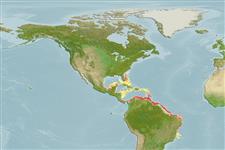Environment: milieu / climate zone / depth range / distribution range
Ecology
Marine; demersal; depth range 70 - 600 m (Ref. 3702), usually ? - 180 m (Ref. 9626). Tropical
Western Atlantic: Panama (Ref. 3702), Colombia, Venezuela, and Trinidad.
Size / Weight / Age
Maturity: Lm ? range ? - ? cm
Max length : 42.0 cm TL male/unsexed; (Ref. 9626); common length : 30.0 cm TL male/unsexed; (Ref. 5217)
Found over mud bottoms between 70-140 m around islands and between 250 and 600 m on the continental slope (Ref. 3702). Feeds mainly on shrimps and small fishes (Ref. 3702).
Life cycle and mating behavior
Maturity | Reproduction | Spawning | Eggs | Fecundity | Larvae
Cervigón, F., 1993. Los peces marinos de Venezuela. Volume 2. Fundación Científica Los Roques, Caracas,Venezuela. 497 p. (Ref. 9626)
IUCN Red List Status (Ref. 130435: Version 2024-1)
Threat to humans
Harmless
Human uses
Fisheries: minor commercial
Tools
Special reports
Download XML
Internet sources
Estimates based on models
Preferred temperature (Ref.
123201): 13.3 - 23.6, mean 19.7 °C (based on 17 cells).
Phylogenetic diversity index (Ref.
82804): PD
50 = 0.7500 [Uniqueness, from 0.5 = low to 2.0 = high].
Bayesian length-weight: a=0.00776 (0.00454 - 0.01328), b=3.11 (2.97 - 3.25), in cm total length, based on LWR estimates for this species & (Sub)family-body (Ref.
93245).
Trophic level (Ref.
69278): 4.1 ±0.70 se; based on food items.
Resilience (Ref.
120179): Medium, minimum population doubling time 1.4 - 4.4 years (Preliminary K or Fecundity.).
Fishing Vulnerability (Ref.
59153): Low to moderate vulnerability (32 of 100).
